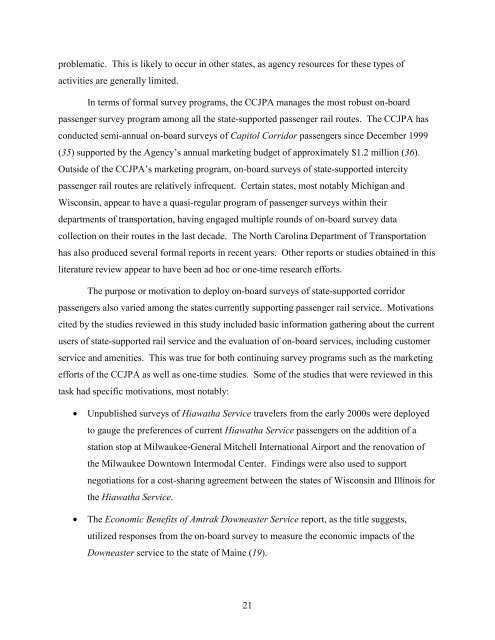Measuring the Benefits of Intercity Passenger Rail: A Study
Measuring the Benefits of Intercity Passenger Rail: A Study
Measuring the Benefits of Intercity Passenger Rail: A Study
Create successful ePaper yourself
Turn your PDF publications into a flip-book with our unique Google optimized e-Paper software.
problematic. This is likely to occur in o<strong>the</strong>r states, as agency resources for <strong>the</strong>se types <strong>of</strong><br />
activities are generally limited.<br />
In terms <strong>of</strong> formal survey programs, <strong>the</strong> CCJPA manages <strong>the</strong> most robust on-board<br />
passenger survey program among all <strong>the</strong> state-supported passenger rail routes. The CCJPA has<br />
conducted semi-annual on-board surveys <strong>of</strong> Capitol Corridor passengers since December 1999<br />
(35) supported by <strong>the</strong> Agency’s annual marketing budget <strong>of</strong> approximately $1.2 million (36).<br />
Outside <strong>of</strong> <strong>the</strong> CCJPA’s marketing program, on-board surveys <strong>of</strong> state-supported intercity<br />
passenger rail routes are relatively infrequent. Certain states, most notably Michigan and<br />
Wisconsin, appear to have a quasi-regular program <strong>of</strong> passenger surveys within <strong>the</strong>ir<br />
departments <strong>of</strong> transportation, having engaged multiple rounds <strong>of</strong> on-board survey data<br />
collection on <strong>the</strong>ir routes in <strong>the</strong> last decade. The North Carolina Department <strong>of</strong> Transportation<br />
has also produced several formal reports in recent years. O<strong>the</strong>r reports or studies obtained in this<br />
literature review appear to have been ad hoc or one-time research efforts.<br />
The purpose or motivation to deploy on-board surveys <strong>of</strong> state-supported corridor<br />
passengers also varied among <strong>the</strong> states currently supporting passenger rail service. Motivations<br />
cited by <strong>the</strong> studies reviewed in this study included basic information ga<strong>the</strong>ring about <strong>the</strong> current<br />
users <strong>of</strong> state-supported rail service and <strong>the</strong> evaluation <strong>of</strong> on-board services, including customer<br />
service and amenities. This was true for both continuing survey programs such as <strong>the</strong> marketing<br />
efforts <strong>of</strong> <strong>the</strong> CCJPA as well as one-time studies. Some <strong>of</strong> <strong>the</strong> studies that were reviewed in this<br />
task had specific motivations, most notably:<br />
• Unpublished surveys <strong>of</strong> Hiawatha Service travelers from <strong>the</strong> early 2000s were deployed<br />
to gauge <strong>the</strong> preferences <strong>of</strong> current Hiawatha Service passengers on <strong>the</strong> addition <strong>of</strong> a<br />
station stop at Milwaukee-General Mitchell International Airport and <strong>the</strong> renovation <strong>of</strong><br />
<strong>the</strong> Milwaukee Downtown Intermodal Center. Findings were also used to support<br />
negotiations for a cost-sharing agreement between <strong>the</strong> states <strong>of</strong> Wisconsin and Illinois for<br />
<strong>the</strong> Hiawatha Service.<br />
• The Economic <strong>Benefits</strong> <strong>of</strong> Amtrak Downeaster Service report, as <strong>the</strong> title suggests,<br />
utilized responses from <strong>the</strong> on-board survey to measure <strong>the</strong> economic impacts <strong>of</strong> <strong>the</strong><br />
Downeaster service to <strong>the</strong> state <strong>of</strong> Maine (19).<br />
21
















